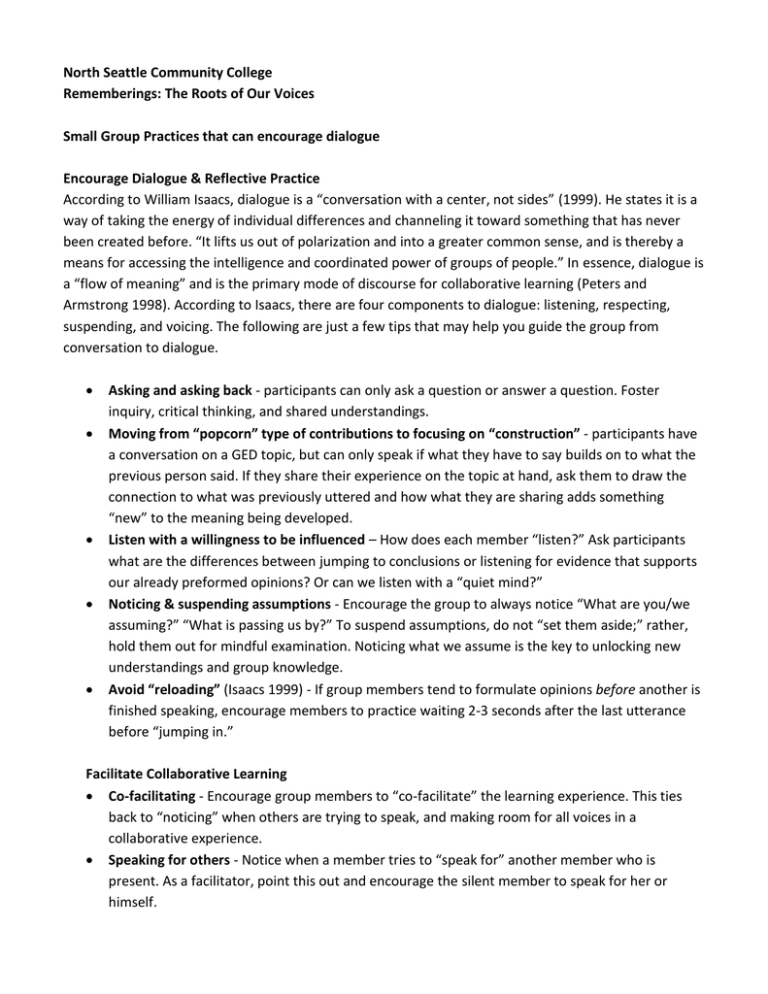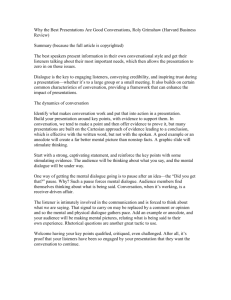North Seattle Community College Rememberings: The Roots of Our Voices
advertisement

North Seattle Community College Rememberings: The Roots of Our Voices Small Group Practices that can encourage dialogue Encourage Dialogue & Reflective Practice According to William Isaacs, dialogue is a “conversation with a center, not sides” (1999). He states it is a way of taking the energy of individual differences and channeling it toward something that has never been created before. “It lifts us out of polarization and into a greater common sense, and is thereby a means for accessing the intelligence and coordinated power of groups of people.” In essence, dialogue is a “flow of meaning” and is the primary mode of discourse for collaborative learning (Peters and Armstrong 1998). According to Isaacs, there are four components to dialogue: listening, respecting, suspending, and voicing. The following are just a few tips that may help you guide the group from conversation to dialogue. Asking and asking back - participants can only ask a question or answer a question. Foster inquiry, critical thinking, and shared understandings. Moving from “popcorn” type of contributions to focusing on “construction” - participants have a conversation on a GED topic, but can only speak if what they have to say builds on to what the previous person said. If they share their experience on the topic at hand, ask them to draw the connection to what was previously uttered and how what they are sharing adds something “new” to the meaning being developed. Listen with a willingness to be influenced – How does each member “listen?” Ask participants what are the differences between jumping to conclusions or listening for evidence that supports our already preformed opinions? Or can we listen with a “quiet mind?” Noticing & suspending assumptions - Encourage the group to always notice “What are you/we assuming?” “What is passing us by?” To suspend assumptions, do not “set them aside;” rather, hold them out for mindful examination. Noticing what we assume is the key to unlocking new understandings and group knowledge. Avoid “reloading” (Isaacs 1999) - If group members tend to formulate opinions before another is finished speaking, encourage members to practice waiting 2-3 seconds after the last utterance before “jumping in.” Facilitate Collaborative Learning Co-facilitating - Encourage group members to “co-facilitate” the learning experience. This ties back to “noticing” when others are trying to speak, and making room for all voices in a collaborative experience. Speaking for others - Notice when a member tries to “speak for” another member who is present. As a facilitator, point this out and encourage the silent member to speak for her or himself. Helping others help themselves - Notice when other members try to “help” a member solve a problem. Encourage them not to provide alternative solutions, but to inquire deeper into why the person chooses to do as they do, so that the individual can identify his/her own underlying assumptions and come to his/her own conclusions. Tracking group process - Keep track of group process as well as topic content. Make “in the moment” decisions based upon group’s subtle reactions. Notice others noticing, notice the balance of responses around the circle. Is the conversation happening only at one end? If so, notice if anyone on the other side is trying to respond and invite them in. Debriefing – members “debrief” or “check out” at the end of the day. They speak to a striking moment they had in group conversation, an “ah-ha” moment that they may not have been able to articulate earlier on in the conversation. This “checking out” is synonymous to everyone “stopping the music” at their own place of choice. References Isaacs, W. Dialogue and the Art of Thinking Together. New York: Doubleday, 1999.



